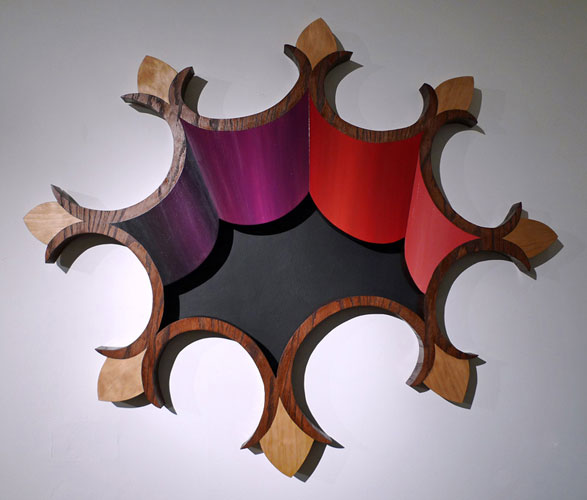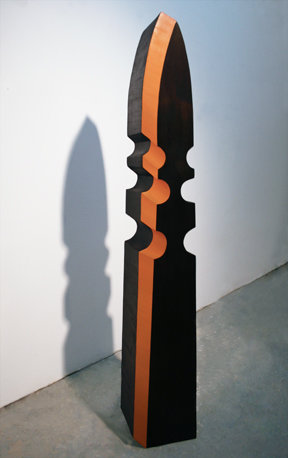This is an archive of the ArtCat Zine, 2007-2009. Please visit our new project, IDIOM.
Rachel Beach at Like the Spice

Towers and Portals
Rachel Beach
7 March - 12 April 2009
Show has been extended
Towers and Portals, at Like the Spice Gallery, is Rachel Beach's second solo exhibition in New York. Beach's seductive sculpture-paintings are postmodern, playful explorations of relativistic perception. Using oil paint and a technique called veneered marquetry, the artist creates trompe-l'oeil forms that easily segue from a two-dimensional to a three-dimensional reading and likewise maneuver between ornamentation and cleverly subversive commentary. Remarkably, the works are as sincere as they are arch.
Impressed with her previous solo effort, Chicken & Egg, at HQ Gallery, I worried that Towers and Portals might evidence a sophomore slump. Happily, Beach avoids that pitfall. Although this nit-picky viewer did notice two instances of hurried handiwork -- some uneven paint on the exhibition centerpiece, The Mothership, and stray paint spotting above Benevolent Universe (yellow and pink) - the large and varied collection of sculptural works on hand at Like the Spice is generally first-rate. In fact, it was Beach's superior craft that compelled me to search for defects in the first place.

Drawing from Escherian optical illusion, Islamic geometric design, cartoons and other graphic wellsprings, Beach's sculpture-paintings are given to conceptual metamorphosis. The Bucaneer, for example, might be interpreted variously as a phallus, crenelation, spear, paintbrush or missile, and the many "portal" works can be viewed as annihilating black holes, avenues of escape, or sexualized orifices. (Indeed, the exhibition's title invites both transcendental and base, sexual interpretations of the artwork.)
The works' plural meaning also evinces a sharp wit. The caduceus-like structure of The White Whale evokes the spout of Melville's allegorical beast, but also calls to mind Captain Ahab's determined folly and The Pequod, the vessel that pursued Moby Dick, a ship populated by an ethnically and religiously diverse crew. The contemporary geopolitical parallels and Melville's then peculiarly American brand of fatalistic optimism are, one senses, all taken into account by Beach.
Reflecting our present ideological uncertainty, the viewer's perception of the work vacillates, but Beach's sculptures respond to this generalized global anxiety by offering a hopeful, aesthetic alternative. The work's charitable heart is most apparent in The Mothership, a large Ouroboros with arabesques replacing the traditional snake's head and tail. The symbol represents eternal recurrence or the cyclical nature of the universe. There is some comfort in this notion of cyclicality; in a world preoccupied by the precipice, it's valuable to contemplate a new beginning, again and again.
ZINE
HOME
TIPS / COMMENTS
CATEGORIES
CONTRIBUTORS
- Greg Afinogenov
- B. Blagojevic
- Adda Birnir
- Susannah Edelbaum
- Julie Fishkin
- Paddy Johnson
- Jessica Loudis
- Christopher Reiger
- Andrew Robinson
- Peter J. Russo
- Blythe Sheldon
- S.C.Squibb
- Hrag Vartanian
